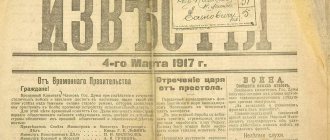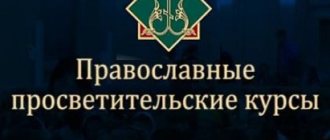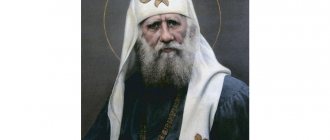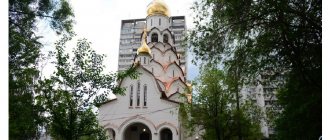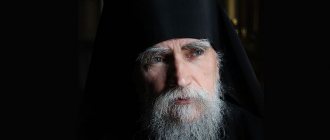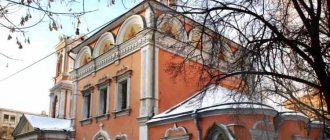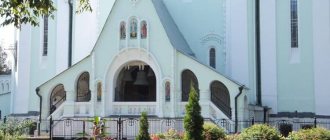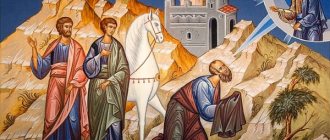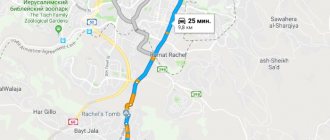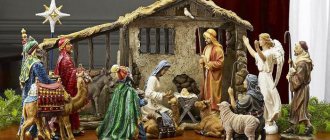Mir
Russia Moscow region working village Bobrovo Church of the Resurrection of Christ and the Holy New Martyrs and Confessors of Russia in Butovo Map is loading…
{"format":"leaflet","minzoom":false,"maxzoom":false,"limit":50,"offset":0,"link":"all","sort":[""], "order":[],"headers":"show","mainlabel":"","intro":"","outro":"","searchlabel":"\u2026 \u0441\u043b\u0435\ u0434\u0443\u044e\u0449\u0438\u0435 \u0440\u0435\u0437\u0443\u043b\u044c\u0442\u0430\u0442\u044b","default":"","import-annotation":false,"width ":"auto","height":"350px","centre":{"text":"","title":"""link":"""lat":55.5309290000000004283720045350492000579833984375,"lon": 37.594593000000003257810021750628948211669921875,"icon":""},"title":"","label":"","icon":"","lines":[],"polygons":[],"circles":[ ],"rectangles":[],"copycoords":false,"static":false,"zoom":8,"defzoom":14,"layers":["OpenStreetMap"],"image layers":[] ,"overlays":[],"resizable":false,"fullscreen":true,"scrollwheelzoom":true,"cluster":false,"clustermaxzoom":9,"clusterzoomonclick":true,"clustermaxradius":80, "clusterspiderfy":true,"geojson":"","clicktarget":"","showtitle":true,"hidenamespace":false,"template":"","userparam":"","activeicon": "","pagelabel":false,"ajaxcoordproperty":"","ajaxquery":"","locations":[{"text":"\u003Cb\u003E\u003Ca href=\"/palomnik/%D0% A5%D1%80%D0%B0%D0%BC_%D0%92%D0%BE%D1%81%D0%BA%D1%80%D0%B5%D1%81%D0%B5%D0%BD% D0%B8%D1%8F_%D0%A5%D1%80%D0%B8%D1%81%D1%82%D0%BE%D0%B2%D0%B0_%D0%B8_%D1%81%D0% B2%D1%8F%D1%82%D1%8B%D1%85_%D0%9D%D0%BE%D0%B2%D0%BE%D0%BC%D1%83%D1%87%D0%B5% D0%BD%D0%B8%D0%BA%D0%BE%D0%B2_%D0%B8_%D0%98%D1%81%D0%BF%D0%BE%D0%B2%D0%B5%D0% B4%D0%BD%D0%B8%D0%BA%D0%BE%D0%B2_%D0%A0%D0%BE%D1%81%D1%81%D0%B8%D0%B9%D1%81% D0%BA%D0%B8%D1%85_%D0%B2_%D0%91%D1%83%D1%82%D0%BE%D0%B2%D0%B5\» title=\»\u0425\u0440\ u0430\u043c \u0412\u043e\u0441\u043a\u0440\u0435\u0441\u0435\u043d\u0438\u044f \u0425\u0440\u0438\u0441\u0442\u043e\u0432\u0 430\u0438\u0441\u0432\u044f\ u0442\u044b\u0445 \u041d\u043e\u0432\u043e\u043c\u0443\u0447\u0435\u043d\u0438\u043a\u043e\u0432 \u0438 \u0418\u0441\u043f\u 043e\u0432\u0435\u0434\u043d\ u0438\u043a\u043e\u0432 \u0420\u043e\u0441\u0441\u0438\u0439\u0441\u043a\u0438\u0445 \u0432 \u0411\u0443\u0442\u043e\u0432\u 0435\u003E\u0425\u0440\ u0430\u043c \u0412\u043e\u0441\u043a\u0440\u0435\u0441\u0435\u043d\u0438\u044f \u0425\u0440\u0438\u0441\u0442\u043e\u0432\u0 430\u0438\u0441\u0432\u044f\ u0442\u044b\u0445 \u041d\u043e\u0432\u043e\u043c\u0443\u0447\u0435\u043d\u0438\u043a\u043e\u0432 \u0438 \u0418\u0441\u043f\u 043e\u0432\u0435\u0434\u043d\ u0438\u043a\u043e\u0432 \u0420\u043e\u0441\u0441\u0438\u0439\u0441\u043a\u0438\u0445 \u0432 \u0411\u0443\u0442\u043e\u0432\u 0435\u003C/a\u003E\u003C/ b\u003E\u003Chr /\u003E\u003Ca href=\"/palomnik/%D0%A1%D0%B2%D0%BE%D0%B9%D1%81%D1%82%D0%B2%D0%BE: %D0%90%D0%BD%D0%BD%D0%BE%D1%82%D0%B0%D1%86%D0%B8%D1%8F\" title=\"\u0421\u0432\u043e\u0439 \u0441\u0442\u0432\u043e:\u0410\u043d\u043d\u043e\u0442\u0430\u0446\u0438\u044f\u003E\u0410\u043d\u043d\u043e\u0442\u0430 \u0446\u0438\u044f\ u003C/a\u003E: "'\u0425\u0440\u0430\u043c \u0412\u043e\u0441\u043a\u0440\u0435\u0441\u0435\u043d\u0438\u044f \u0425\u0440\u0 438\u0441\u0442\u043e \u0432\u0430 \u0438 \u0441\u0432\u044f\u0442\u044b\u0445 \u041d\u043e\u0432\u043e\u043c\u0443\u0447\u0435\u043d\u0438\u043a \u043e\u0432 \u0438 \u0418\u0441 \u043f\u043e\u0432\u0435\u0434\u043d\u0438\u043a\u043e\u0432 \u0420\u043e\u0441\u0441\u0438\u0439\u0441\u043a\u0438\u0445 u0432\u0411\u0443\u0442\u043e \u0432\u0435"' \u043f\u043e\u0441\u0442\u0440\u043e\u0435\u043d \u0432 2007 \u0433\u043e\u0434\u0443. \u0420\u0430\u0441\u043f\u043e\u043b\u043e\u0436\u0435\u043d \u043d\u0430\u043f\u0440\u043e\u0442\u0438\u0432 \u0442\u0435\ u0440\u0440\u0438\u0442\u043e \u0440\u0438\u0438 \u0431\u044b\u0432\u0448\u0435\u0433\u043e \u043f\u043e\u043b\u0438\u0433\u043e\u043d\u0430 \u041d\u041a \u0412\u0414-\u041a\u0413\ u0411 \u043e\u0444\u0438\u0446\u0438\u0430\u043b\u044c\u043d\u043e \u043f\u0440\u0438\u0437\u043d\u0430\u043d\u043d\u043e\u0 433\u043e\u043c\u0435\u0441\ u0442\u043e\u043c \u043c\u0430\u0441\u0441\u043e\u0432\u044b\u0445 \u0437\u0430\u0445\u043e\u0440\u043e\u043d\u0435\u043d\u0 438\u0439\u0436\u0435\u0440\ u0442\u0432 \u043f\u043e\u043b\u0438\u0442\u0438\u0447\u0435\u0441\u043a\u0438\u0445 \u0440\u0435\u043f\u0440\u0435\u0441\u0 441\u0438\u0439.","title ":"\u0425\u0440\u0430\u043c \u0412\u043e\u0441\u043a\u0440\u0435\u0441\u0435\u043d\u0438\u044f \u0425\u0440\u0438\u0441\u04 42\u043e\u0432\u0430\ u0438 \u0441\u0432\u044f\u0442\u044b\u0445 \u041d\u043e\u0432\u043e\u043c\u0443\u0447\u0435\u043d\u0438\u043a\u043e\u0432 \u 0438\u0418\u0441\u043f\u043e\ u0432\u0435\u0434\u043d\u0438\u043a\u043e\u0432 \u0420\u043e\u0441\u0441\u0438\u0439\u0441\u043a\u0438\u0445 \u0432\u0411\u 0443\u0442\u043e\u0432\u0435" ,"link":"","lat":55.5309290000000004283720045350492000579833984375,"lon":37.594593000000003257810021750628948211669921875,"icon":""}], "imageLayers":[]}
55.530928; 37.594593
Russia, Moscow region, Leninsky urban district, working village Bobrovo, territory of DNT Butovo, Yubileynaya street, 2
working village Bobrovo, Moscow region
Russia
Telephone:
+7 (909) 974 62 99
Church of the Resurrection of Christ and the Holy New Martyrs and Confessors of Russia in Butovo
built in 2007. Located opposite the territory of the former NKVD-KGB training ground, officially recognized as the site of mass graves of victims of political repression.
History[[edit]h2>
Near the place where mass executions and burials of victims took place from 1935 to the early 1950s, the Orthodox Church of the New Martyrs and Confessors of Russia was built in Butovo. In 1994, on Radonitsa, on the site of the construction of the future temple, a wooden cross was erected; on May 5, 1994, with a large gathering of Orthodox clergy, the place where Russian martyrs were executed for the faith was consecrated.
In 1995, the burial area with an area of about 6 hectares was transferred to the Russian Orthodox Church, and through the efforts of the community created from the relatives of the victims, a small wooden church was built here and the improvement of the burial began. On May 15, 2004, at the site of the foundation stone of the future cathedral, Patriarch Alexy II of Moscow and All Rus' celebrated a memorial service. The first official delegation of the ROCOR, headed by its First Hierarch, Metropolitan Laurus (Shkurla), who was in Russia from May 15 to May 28, 2004, was present at the service. Within a year, the main stage of capital construction of the temple was completed, and on May 28, 2005, Patriarch Alexy II consecrated the cross, which was installed on the main dome of the temple. On December 11, 2006, a minor consecration of the temple took place, coinciding with the day of remembrance of the New Martyr Metropolitan Seraphim (Chichagov). The consecration of the cathedral stone church in Butovo took place on May 19, 2007, two days after the signing of the act of reunification of the Russian Church Abroad with the Mother Church.
The first floor of the temple is dedicated to the memory of the suffering of the new martyrs. In the narthex of the temple on the walls there are pre-mortem photographs of the victims in Butovo. On two display cases under the photographs there are things taken from the burial ditch during the 1997 excavation - shoes, clothing items, rubber gloves, shell casings and bullets. There are more than fifty icons of Butovo saints on the walls. On the two western pillars are placed six icons of the hierarchs who suffered in Butovo, headed by Metropolitan Seraphim (Chichagov).
Memorial
Since the end of 1997, funeral services began to be held in the administration building of the village of Drozhzhino, near the entrance to the landfill.
On the territory of the training ground there are stands with the names of 935 killed ministers and other members of the Russian Orthodox Church. The memorial complex is open to visitors on weekends.
Entrance to the well-groomed territory is free. More than 10 thousand people come here every year. People visit the attraction, both as part of pilgrimage groups and in small parties. Groups of pilgrims are accepted every day from 10:00 to 15:00, by appointment.
A tour of the memorial complex takes 1.5 - 2 hours. It includes a visit to the burial grounds and parish churches, tells about the history of the Butovo site, the period of mass repression and persecution of the Russian Orthodox Church in the 20th century.
You can get more information about the date of the excursion or the time it takes place by calling.
Architecture[[edit]h2>
The Church of the Resurrection of Christ and the Holy New Martyrs and Confessors of Russia at the Butovo site was built in the tradition of tent architecture. The closest in appearance is the wooden three-tent cathedral in Kemi, which to some extent was the prototype of the temple in Butovo.
The architect M.Yu. Kesler proposed an original solution: to slightly deepen the foundation of the temple and sprinkle the western part of the temple with earth to create the impression of a hill. Now, to get to the reliquary, you need to go down the stairs, as is usually done when descending into the crypt, where the remains of saints are kept in Greek temples.
The first floor of the temple is dedicated to the memory of the suffering of the new martyrs and confessors of Russia. In the narthex of the temple on the walls there are pre-mortem photographs of the victims in Butovo. In the lower floor of the temple complex there is a reliquary with the remains of personal belongings, utensils, and vestments of the New Martyrs. There are more than fifty icons of Butovo saints on the walls. On the two western pillars are placed six icons of the hierarchs who suffered in Butovo, headed by Metropolitan Seraphim (Chichagov).
On the bell tower of the temple there is a large set of bells cast at the Tutaevsky Bell Factory. The bells also depict the faces of the New Martyrs and Confessors of Russia, including the Royal Passion-Bearers.
Service schedule, operating hours, contacts
The territory of the memorial complex and the parish churches are ready to receive visitors every day from 10:00 to 17:00, a detailed schedule of services in the Church of the New Martyrs, contacts for ordering excursions and information about the temple are published on the website of the memorial complex in Butovo.
This memorial complex is the largest monument to the victims of Stalin’s repressions in the Russian Federation, so every person needs to read a book about it published on the Butovo training ground website and personally visit it.
Saints[[edit]h2>
The Butovo site is a real shrine with relics: out of more than 20 thousand who died here, 330 Butovo New Martyrs were canonized. The host of clergy who suffered here for their faith is led by seven bishops: a metropolitan, two archbishops and four bishops. Along with them, many archimandrites, archpriests, abbots, hieromonks, priests, deacons and hierodeacons, monastics and ordinary employees of the Church were shot.
The patron of the Temple is the holy martyr Seraphim Chichagov. From the first days of the construction of the temple, special patronage of this work was noticed by Bishop Seraphim (Chichagov), Metropolitan of Petrograd, who was shot at the training ground in Butovo on December 11, 1937. By that time, the metropolitan had not yet been canonized, but his holy help was felt by those who were involved in the construction of the temple at the burial site.
On December 11, 1995, a cross was erected over the temple, and exactly a year later, on the day of the execution of Metropolitan Seraphim and 126 other people sentenced to death by the UNKVD Troika, the wooden temple was consecrated. The active organizer of the temple was the granddaughter of the metropolitan, the abbess of the Novodevichy Convent being recreated at that time - Mother Seraphima (in the world Varvara Vasilyevna Chichagova-Chernaya, a famous chemist, doctor of sciences, professor).
Story
The village of Drozhzhino was first mentioned in the middle of the 16th century, when the estate of the boyar F.M. Drozhzhin was located here. It is known that at the end of the 19th century. the owner of the estate, N. M. Solovyov, founded a stud farm on the territory, and built a hippodrome near the forest. After the October Revolution, I.I. Zimin (who was the owner of the estate at that time), without waiting for confiscation, transferred the entire farm to the government, and he himself went abroad.
In 1920, an agricultural colony of the OGPU appeared in Butovo. In 1934, the Butovo training ground was created here, which was used as a shooting range for the NKVD (the territory occupied 2 sq. km). The shooting range was surrounded by a solid fence, was under round-the-clock armed guard and was perfect for executions.
Convicts were sent towards the Drozhzhino estate in the evenings on grain trucks. At the training ground they were placed in a long barracks, where roll call and verification of people took place.
Immediately before the execution, the victim’s face was compared with the photograph on the documents, after which the verdict was announced. The action continued until dawn.
© jY-m-htp
The capital's cemeteries could not accommodate such a number of executed people, so people were buried like a layer cake - they killed those standing near the ditch, covered them with earth, and buried the next victims on top. There are 13 such pits at the site. The width of each was 4–5 m, and the depth reached 4 m.
In the summer of 1937, executions reached such proportions that there were no longer enough burial pits for burying bodies. Then, with the help of an excavator, they began to dig trenches 3–5 m long and 3.5 m deep.
After the cessation of mass executions, in 1938 the tract began to be used for the burial of those who were shot in Moscow prisons.
During World War II, a camp for German prisoners of war was created in the area of the Russian Calvary. Their forces were involved in the construction of the Warsaw Highway. Those who refused to take part in the construction were shot and thrown into the ditch.
Lists of those executed on Google Maps panorama
Shrines[[edit]h2>- Icon with particles of the relics of Solovetsky saints;
- an icon with particles of the relics of Murom saints;
- an icon with particles of the relics of St. John of Shanghai and San Francisco, the wonderworker;
- an icon with particles of the relics of St. Patriarch Tikhon;
- an icon with particles of the relics of the Venerable Martyr Elizabeth Feodorovna;
- a particle of brick from the Ipatiev House - the site of the martyrdom of the Royal Passion-Bearers;
- fragment of the shawl of the Royal Passion-Bearer Tsarevich Alexy;
- Gospel with a dedicatory inscription from the Passion-Bearer Empress Alexandra.
The beginning of the creation of the memorial
Despite the fact that the idea to build the Church of the New Martyrs and Confessors of Russia in Butovo arose at the very beginning of archival work, it was finally formed in the spring of 1993, when the territory of the test site was first opened for visits by relatives of those killed and buried here. At the beginning of winter of the same year, a granite memorial plaque was installed at the site.
Before the Church of the New Martyrs and Confessors of Russia was erected in Butovo, a wooden Poklonny cross, made by craftsmen of the Orthodox St. Tikhvin Institute according to the sketches of the sculptor and architect D. M. Shakhovsky, became a symbol of the memory of all those who died here. His father, Archpriest Mikhail (Shika), was also shot at the firing range, sharing the fate of hundreds of thousands of innocent victims. The consecration of the Worship Cross took place on the eve of Victory Day 1994.
Patronal holidays[[edit]h2>
Resurrection of Christ (Easter)
— Rolling date
Icon of the Most Holy Theotokos “Sovereign”
- March 15th
John of Shanghai and San Francisco, Saint
— July 2
Seraphim Chichagov, martyr
- December 11th
Tikhon, Patriarch
— April 7, October 9, November 18, February 22.
The Church of the New Martyrs in Butovo is a monument to standing for the faith. Conversation with Rev. Kirill Kaleda
Are there many monumental churches being built in modern Russia? And how to reflect in church architecture and decoration the memory of the historical event to which the temple is dedicated? The Church of the New Martyrs and Confessors in Butovo is perhaps one of the best examples of such a temple. The architecture, decoration, and paintings form a harmonious unity, again and again speaking about the dedication of the shrine in the language traditional for the Orthodox Church. Our correspondent talked with the rector of the Church of the New Martyrs and Confessors of Russia in Butovo, Archpriest Kirill Kaleda.
– The temple bears the name of the Holy New Martyrs and Confessors of Russia, but its central chapel is dedicated to the Resurrection of Christ. Why?
– This was done with the blessing of Patriarch Alexy II. His Holiness felt that faith in the Resurrection of Christ was the rock on which the new martyrs stood. The right aisle of the upper church is consecrated in honor of the Council of New Martyrs and Confessors of Russia, the left - in the name of Patriarch Tikhon. In the lower church, the central chapel is dedicated to the “Sovereign” Icon of the Mother of God, the right one is dedicated to the Hieromartyr Seraphim (Chichagov), and the left one is dedicated to St. John of Shanghai, a saint of the Russian Church Abroad.
- Why him?
– The Church of the New Martyrs was founded during the first visit to Russia of the head of the Russian Orthodox Church abroad, Metropolitan Laurus; The bishop took part in laying the first stone. This happened on May 15, 2004, on the day of remembrance of the holy noble princes Boris and Gleb, which then coincided with the Cathedral of the New Martyrs of Butovo. Metropolitan Laurus also arrived at this service at the invitation of His Holiness the Patriarch. Then we built the temple - and at that time there were negotiations about the reunification of the Russian Church. And the consecration was specially timed to coincide with this event - it took place two days after the signing of the act on the restoration of canonical communion within the Russian Orthodox Church, and it was headed by Patriarch Alexy and Metropolitan Laurus. So this temple is not only a monument to the new martyrs, but also a sign of the unity of the Russian Church.
– Is the appearance of the Church of the New Martyrs connected with the idea inherent in its dedication? How did it develop?
– The search for the external appearance of the temple proceeded gradually. We understood that in the place where so many of our compatriots suffered - and many of them for their faith, and 332 are now glorified as saints - there should be a monument temple in this place, worthy of their feat in size and decoration. And of course, the small wooden temple, which in the nineties was erected at the burial site of the murdered, did not correspond in scale to what was happening at this place. Because here, one can say without exaggeration, events of a universal order took place.
– Why is the stone temple located outside the main territory of the test site?
- That's not entirely true. The Butovo training ground is a special zone with an area of two square kilometers, the fencing of which in the 1930s ran along the Warsaw Highway on the western side and reached the village of Bobrovo in the east. In its central part, an internal fence was made where executions and burials were carried out - a place that today is most often called a training ground. Next to it were the remains of a manorial estate, in the building of which the commandant’s office of the special zone was located. The temple was built near this building, because a large stone construction on the execution site itself would undoubtedly not only change its appearance, but also damage the burials.
– Why was the temple built exactly like this – with five tents?
– When we were looking for the image of this temple, we turned to different architects who proposed various solutions: for example, to build a church on the model of the ancient pantheon... But we were looking for an opportunity to reflect what happened on our land precisely in the Russian tradition. They began to research the Russian history of building monuments “on blood” - and it is very ancient. We noticed that churches erected in memory of tragic events, in particular wars, often had tent-roofed architecture. The first, wooden church, built on the site of the murder of Tsarevich Dimitri (it has not survived to this day) was tented. The Church of the Passion of the Lord in Aleksandrovskaya Sloboda, erected in memory of those killed during the oprichnina years, has a tent-roofed architecture. The central chapel of the Church of the Savior on Spilled Blood at the site of the assassination of Emperor Alexander II is tent-roofed. No multi-tent churches have survived to this day. There is a description of a five-tent temple that was once in Staritsa, but we have not even reached its images, only a description in the chronicle. The closest temple in architecture that exists today is the wooden cathedral in Kemi, built in the 18th century. When we settled on the option of a tented temple, it was proposed to place the side tents not in the corners of the quadrangle, like the side domes of five-domed churches, but along the axes: east, west, north, south. Thus, when viewed from above, the temple has the shape of a cross, which recalls the suffering that was committed at this place.
– The vestibule of the lower church is practically a museum, or, better to say, a reliquary, where many things related to the new martyrs are collected. Are the relics of the new martyrs there?
– Today, more than 1,700 new martyrs and confessors have been glorified in Russia – and only about fifty of them have had their relics recovered. We either do not know where the remains of these saints rest, or they are in a common grave and it is almost impossible to identify them. So we are unlikely to find the relics of most of the new martyrs due to the circumstances of their death and burial. But by the time the temple was erected, through the efforts of our community, a number of shrines had been acquired. These were also supplemented by items brought by the relatives of the victims. Therefore, the lower temple was originally conceived as a reliquary, where the shrines would be available for worship.
– The mood evoked by the decoration of the upper and lower temples is very different...
– We realized that stylistically the lower church should be dedicated to the experience of the suffering of the new martyrs, and the upper one should be dedicated to the glorification of their feat. To get to the lower temple, you need to go down the stairs. The first thing that greets us in the vestibule are photographs of the victims taken from archival investigative files. These photographs were taken literally a few days before the execution. There, in two display cases, there are things that belonged to the murdered and which were recovered from the burial ditches during archaeological research carried out with the blessing of His Holiness Patriarch Alexy II in 1997. Then a section of one of the burial ditches was opened and examined in detail. We tried not to disturb the bodies, they all remained in the burial, but some of the things were confiscated - some of them are located in display cases. As you understand, we cannot determine whether these things belonged to the new martyrs or other victims. Other display cases display things that belonged to people who suffered for their faith: the holy martyrs Sergius Kedrov, Sergius Goloshchapov: a Eucharistic set, a shroud, diaries... Along the walls of the lower church there are 51 icons of the new martyrs killed in Butovo. They are depicted on these icons collectively - according to the days of their martyrdom. (We celebrate the memory of the Butovo new martyrs 51 days a year - according to the days of their execution.) At first we had the idea of painting an icon of every Butovo saint, but then we realized that we simply did not have enough walls. The images are arranged in calendar order. If you want, this is our, Butovskaya, menaia. We remove these icons from the wall on the appropriate day and place them on the central lectern as a festive image. Above the royal doors of the lower church hangs an icon of the Savior that belonged to the hieromartyr Sergius Kedrov. Here, in the lower temple, we are surrounded by those saints who suffered in this place.
– Work on the paintings of the upper temple has been going on for about two years. What is the purpose of these murals?
– By the grace of God, the work is almost completed. The idea of the painting implies that the temple is, in the words of one of the clergy who suffered here, “a piece of heaven on earth.” Therefore, in ornamental decorations we used images of paradise plants, animals, and birds. And among this ornamental environment, symbolizing paradise, they tried to tell in an iconographic way about the feat of the Church, starting from the first times and ending with the last. The vault of the central drum of the upper temple depicts the Lord Almighty. An example of iconography for him was the icon of the Savior, painted on the wall of the Church of the Great Lavra on Athos. Looking at the murals from top to bottom, we seem to be descending through the years of history. The central drum depicts the ancient righteous, forefathers, and prophets. Since the central chapel is dedicated to the Resurrection of Christ, the appearance of the Savior to the disciples after His rising from the dead is written in the lower part of the drum. In the left chapel, consecrated in honor of St. Tikhon, the successor of the apostles, in the drum you see episodes from their lives, in particular the martyrdom. In the right side chapel, the drum depicts ancient martyrs and their suffering. And the lower part of the painting is dedicated to the feat of the new martyrs. In the chapel of the New Martyrs on the eastern wall there is the Cathedral of the New Martyrs and Confessors of Russia, and on the western wall there is a fresco of the murder of the Royal Family. Also there you can see other episodes of suffering for faith in the twentieth century, in particular on Solovki. In the left aisle, part of the frescoes is dedicated to the life of St. Tikhon from his birth to the miraculous discovery of his relics, which occurred due to the fire in the cathedral of the Donskoy Monastery. Images of the Butovo new martyrs: a row of 51 life-size figures - a representative from each day of execution. Hieromartyrs who suffered not only in Butovo are written on the arches and cross vaults. They are located in such a way as to testify that the persecution of the Church and the feat of standing up for the faith did not take place just somewhere in one place, but throughout our entire country. And those saints who performed their episcopal and suffering feats in the southern regions of Russia are depicted in the southern part of the church, those who served in the north are depicted in the northern. We see that, despite the fact that in the twentieth century there was the Soviet Union on this part of the earth, it remained Holy Russia.
– Alongside the paintings dedicated to the Passion of Christ are images of new martyrs. Is there any special purpose to this?
- Yes. In the altar painting of the central chapel in the conch, of course, the Resurrection of Christ is depicted, and in other places - episodes from the suffering of the Savior: the betrayal of Judas, interrogation by Pilate, scourging, crucifixion, removal from the Cross... In the arch that adjoins the southern wall, where The Passion of Christ is depicted, the faces of the new martyrs who suffered in the most cruel way are painted. For example, Saint Tikhon of Voronezh, who was crucified on the royal gates; Saint Methodius of Peter and Paul - he served in Kazakhstan and came out of the cathedral in vestments to calm the raging crowd of soldiers, but was stabbed with bayonets, and an altar cross was inserted into one of the wounds from which blood flowed. Opposite the fresco of the burial of the Savior are painted the saints who carried out the feat of the myrrh-bearers - the feat of unnoticed service to the Savior and His suffering. This row is headed by the venerable martyrs Grand Duchess Elizabeth and nun Varvara, adjacent to them is the martyr Tatiana Grimblit, who was killed at the Butovo training ground: she devoted her entire life to serving the arrested clergy, she herself was subjected to repression more than once and was finally shot... The priestly confessor Georgy (Sedov) is also depicted, who worked hard to alleviate the suffering of the priest Afanasy (Sakharov), and others. The principle of juxtaposition of images of new martyrs with scenes from more ancient church history, close to them in spirit, can be traced in other places of the painting. For example, near the fresco of the murder of the Royal Family, Russian princes who suffered for their faith are written in the arch: the blessed Andrei Bogolyubsky, Saints Boris and Gleb and others. And near the fresco depicting the arrest of Patriarch Tikhon are the ancient saints of the Russian land who were persecuted by the authorities: Saint Philip, Hieromartyr Hermogenes, Venerable Martyr Cornelius of Pskov-Pechersk and others.
– Both painting the icons of the lower temple and painting the upper one is a huge job. Who did it?
– What is happening here, at the Butovo training ground, is accomplished by the leadership of God – of course, carried out through people. As a participant in these events, I can say that decisions are made collectively - as a result of discussions, often difficult. Our benefactor, the servant of God Oleg, takes a great part - I will refrain from mentioning his last name. Several architects took part in the search for the architectural appearance of the temple. The first draft design belongs to Andrei Sergeevich Tutunov. Both of his grandfathers died in the camps, so this topic is very close to him. But due to a number of circumstances, he did not have the opportunity to develop a project for such a large-scale structure. Therefore, the design of the temple was carried out by Mikhail Yuryevich Kesler, who at that time worked in the “Archtemple” - an organization that, in particular, restored the Cathedral of Christ the Savior. The head of the “Archtemple” workshop, Andrei Nikolaevich Obolensky, also took this work very close to his heart and helped ensure that the project was implemented - by the way, his own grandfather lies here, at the Butovo training ground. The icons decorating the lower church were painted in the Moscow icon-painting workshop by Igor Drozdin and his co-workers. The painting of the upper church was carried out by icon painter Konstantin Okhotin and his team. The idea for this painting was born jointly, in a discussion in which icon painters, clergy, and the church’s patron took part. Of course, we did not dare to “guide the icon painter’s hand.”
– The difficulty of painting icons of new martyrs is that you often have to develop the iconography of saints that no one has painted yet...
- Yes. As a rule, when creating a mural, they are guided by already existing programs, or even try to copy ancient frescoes, so, as one bishop said, many modern artists who decorate churches are not painters, but “painters.” This word does not apply to the artists who worked in the Church of the New Martyrs. Of course, we relied, for example, on the marks of the icon of the new martyrs and confessors of Russia. But basically the painting of this temple is a completely new work. But creating images of new martyrs is a very difficult task. It is necessary to paint the canonical face of the saint - and at the same time ensure that the image retains recognition, certain portrait features. The situation is complicated by the fact that, if not all, then many of the new martyrs still have relatives, some of whom remember their holy ancestors alive. And if they haven’t seen it, they have formed a certain image in their minds: from photographs, from the stories of their elders. A good example. The icon painter, a professional in his field, painted an image of the new martyr, and his son, seeing him, said that the icon did not look like his father at all. And looking at the image made after that by another master, he said: “Yes, this is it.” Both icon painters worked from the same photographs. By the way, it happens that only one photo has survived - from the investigative file, and then the work of the icon painter is complicated: it is difficult to understand from the photograph of a shorn, emaciated man what he looked like in normal life, what kind of beard and hair he had... Imagine what kind of work - write three hundred faces in a fairly short period of time. This is a colossal job!
– Does the iconography developed as a result become a model for painting these saints?
“Relatives of the new martyrs, representatives of the churches where they served, contact us and ask if we have their icons. Now it happens like this: children are baptized in honor of the new martyrs - and parents and godparents look from us for an example of the image of the heavenly patrons of their children.
– Do the iconostases of the temple indicate its dedication to the new martyrs?
– They contain rich symbolism: for example, the cross built into the royal doors of the lower temple. The iconostases, including the icons and icon cases themselves, were created by masters of the Holy Trinity Brotherhood in the city of Shchigry. It was not an easy job. In the upper church, the images of the local row are very interesting: the space between the pillars is such that it was necessary to paint either very narrow or wide icons. But how to make the icons of the Savior and the Virgin Mary wide? An unusual solution was found: stamps were placed around the images of the Savior Not Made by Hands and the Kazan Mother of God, and episodes from the lives of the new martyrs were written in these stamps. And the icons turned out to be exactly for this temple - in another place they would have seemed strange, but here they are what is needed.
“Society has not fully realized the feat of the new martyrs...”
The Church of the New Martyrs and Confessors of Russia, erected on the Butovo training ground, which acquired terrible fame in the 30s of the twentieth century, is known throughout Russia. This place of extreme suffering - the shooting of thousands of innocent people - has today become a place of prayer and remembrance. A whole host of martyrs for Christ suffered here: bishops, clergy, monastics, and ordinary lay believers. Here the memory of them is kept; on the days of executions - and this is more than a hundred days a year - memorial services are held, and a scientific and educational center operates, studying historical materials related to them. Our correspondent talked with Archpriest Kirill Kaleda, rector of the Church of the New Martyrs and Confessors of Russia in Butovo, about the importance of venerating the New Martyrs and how the parish of the church works to preserve historical memory.
– Is the veneration of the new martyrs growing or decreasing these days?
- Undoubtedly, it is growing. This is evidenced by the number of people who come here and show interest. It is gratifying that the composition of these people is changing. When we started serving here, apart from those who came simply to pray, as in a parish church, mostly relatives of the victims came here who remembered them personally: children, sometimes grandchildren. Once the wife of the murdered man came, another time - his younger brother. Now great-grandchildren are coming - not only people glorified as saints, but also those simply killed, who learned that one of their ancestors was shot. They often have very fragmentary information - after all, people were afraid to talk about their repressed relatives. So, several people about forty came to us and said that their great-uncle was a monk and suffered. When they named the name, it turned out that this was the Hieromartyr Nikolai (Dobronravov), Archbishop of Vladimir and Suzdal, a fairly well-known theologian, member of the Council of 1917. His candidacy was discussed for the post of rector of the Moscow Theological Academy. That is, a truly significant person - but the family did not preserve any information, only that he was a monk and disappeared somewhere... And this case is not an isolated one. Sometimes people, having learned that one of their relatives suffered innocently, begin to look for some materials about them, go to archives, ask their grandparents; some even become churched through this work. From my point of view, this is very important.
- Do they address the memory of the new martyrs at the parish level - I mean not your church, but the parishes where, perhaps, one of those who later suffered for the faith served?
– If at first only a few parishes in Moscow and the Moscow region showed interest in the feat of the new martyrs, now they come to us from many churches, they say: “Our priest suffered ...” - they serve a memorial service or prayer service, ask for materials, sometimes share information that they We managed to find them locally.
– That is, the feat of the new martyrs is worthily revered today?
– Unfortunately, we cannot say this. By and large, of course, neither our church society nor the secular society has realized what happened in Russia in the twentieth century. From my point of view, this is quite sad. And an amazing thing happened, in secular terms, heroic, but in church terms - a miraculous stand for the faith, when not one, not two, not ten or a hundred, but hundreds of thousands of people - maybe we should talk about millions - testified to their faith, despite the terrible conditions, the threat of repression even to the point of death. They were not afraid to say that they believed in Christ. Of course, we must speak everywhere about the feat of the new martyrs and confessors and about the colossal tragedy that occurred in Russia, when our people were seduced by the idea of building the Kingdom of God on earth and paid a terrible price for it. And I cannot exclude that the losses that our people suffered in the twentieth century could lead to national death if we still do not realize what happened.
“But it seems that the church people have realized everything; On the holidays of the New Martyrs of the Russian Land and the New Martyrs of Butovo, whole hosts of worshipers gather here...
– Three to four thousand people are present at the Patriarchal service in memory of the Butovo new martyrs. And in this land - only according to documents - there are 21 thousand. At the memorial service that we serve on a weekday in memory of one of the executions, at best ten grandmothers are present... And when was the service held in memory of one of the new martyrs in your parish church? Are they at least remembered during holidays on memorial days?
– What can be done to make our people more deeply aware of the significance of the feat of the new martyrs?
– Initially, our community set the task not of studying the lives and feats of the new martyrs, but of preserving this place. Our parish and the scientific and educational center created with it carried out some scientific work. Without exaggeration, I will say that I do not know where else such a study of the memorial culture of Russia has been carried out. We have more than five hundred storage units for a variety of things - from unique liturgical objects to some very small notes, etc. We are interacting with the relatives of the victims and the parishes where they served. We have staff who conduct tours for visitors and, in turn, record information provided by guests. Unfortunately, we do not yet have the opportunity to summarize the received materials in the same way as St. Tikhon’s University does: we still have a parish church, and not even in Moscow, but in the Moscow region... Now we are creating a database linked to a map, which will reflect places of service of the Butovo new martyrs - so that parishes, local historians, and pilgrimage services know where the life path of this or that saint took place.
— Did your ancestors suffer during the years of persecution?
– Yes, my grandfather suffered here in Butovo.
– You come from an extraordinary family: your father was a secret priest, almost all of your brothers and sisters became ministers of the Church. How did this happen?
– Probably through the prayers of my grandparents. They dreamed of having twelve children and all of them becoming preachers of the word of God. My grandfather had an unusual fate. His father was a purebred Armenian, and his mother was a German from the Volga region. Oddly enough, Lutheranism was quite widespread among the Armenian intelligentsia at the beginning of the century. Great-grandfather was educated in Switzerland. When his first wife died and several children remained - and he lived in Saratov at that time - he turned to the Lutheran community and asked for help in raising them. He did not think about marriage then. The great-grandmother responded for Christian reasons - and later the great-grandfather proposed marriage to her. From this marriage a grandfather was born. He was raised Lutheran. In his youth he converted to Baptistism. He was one of the leaders, and in the twenties, the head of the Russian student Christian movement, which united both Protestants of various persuasions and Orthodox Christians. And my grandmother came from an ancient Russian, Moscow Alekseev family - her relative was, for example, Nikolai Aleksandrovich Alekseev, the first head of the Moscow City Duma. It so happened that my grandmother did not meet any sufficiently bright Orthodox priests in her life and converted to Baptistism. She died quite early, being, unfortunately, a Baptist. And my grandfather accepted Orthodoxy after her death. He became a priest, was arrested three times and was finally shot. This is Hieromartyr Vladimir Ambartsumov, my mother’s father. Grandfather received a higher education; in the years when he did not have the opportunity to serve, he worked in a number of scientific organizations and has many copyright certificates. And my father was his spiritual son... Dad came from a believing family and was always a deeply religious person. He worked as a geologist most of his life. In 1972, he secretly accepted ordination as a priest, and for eighteen years, in our home every Sunday, every major holiday, the Divine Liturgy was celebrated, and other sacraments were performed. So, dad married the architect Mikhail Yuryevich Kesler at our house - the same one who later developed the design of our temple. I, my brothers and sisters also have experience in different fields: two of us are geologists, the rest are doctors. There were six of us; my older brother Sergei died in a car accident. He took an active part in the development of the Butovo training ground and in the construction of a wooden church. The second older brother, John, is the rector of the Trinity Church on Gryazekh, on Pokrovka. The younger sister worked for ten years as a resuscitation nurse at the Filatov Hospital, now she is the abbess of the Conception Monastery, Abbess Juliana, in fact its renovator. Another sister, Alexandra, was married to the now deceased father Alexander Zaitsev, a cleric of the St. Petersburg diocese. Now she lives in the Conception Monastery. And his younger brother Vasily is a physician, psychiatrist, professor at St. Tikhon’s University.
Interviewed by Alina Sergeychuk
08/28/2013
How to get there[[edit]h2>
Address:
Moscow region, Leninsky district, pos. Butovo, st. Yubileinaya, 2. Church of the Resurrection of Christ and the Holy New Martyrs and Confessors of Russia in Butovo.
Directions:
from the metro station “Dmitry Donskoy Boulevard” by bus No. 18. No. 108 to the “Novo-Nikolskoye” stop, then walk about 800 meters; No. 94 to the stop “2-Melitopolskaya 17”, then walk about 800 meters or by electric train from the Kursky station to the station “Butovo”, then walk about 1.5 km.
Telephone:
+7 (909) 974 62 99
How to get there
The Butovo training ground is located outside the Moscow Ring Road, south of Moscow. You can get here by bus or car. Near the cemetery there is a ground transport stop “Butovo Polygon”. Buses No. 18 and 379 run here.
You can also get to the test site in your own or rented car. Free public parking with 50 spaces is located nearby.
It is convenient to get to the tract by taxi using the following applications: Uber, Gett, Maxim, Yandex. Taxi, Lucky and many others.
History of the Butovo test site
